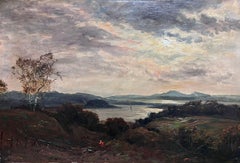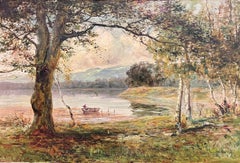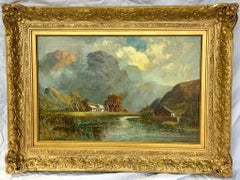John Hamilton Glass Art
to
2
2
2
Signed Victorian Scottish Oil Painting Atmospheric Loch Scene at Dusk
By John Hamilton Glass
Located in Cirencester, Gloucestershire
Benderloch, Argyllshire
by John Hamilton Glass (British, fl.1890-1925)
signed
oil on canvas, unframed
canvas: 16 x 24 inches
inscribed verso
provenance: private collection, England
...
Category
Late 19th Century Victorian John Hamilton Glass Art
Materials
Oil
Fine Victorian Scottish Oil Painting Figures in Highland Loch Landscape signed
By John Hamilton Glass
Located in Cirencester, Gloucestershire
The Highland Loch
by John Hamilton Glass (British, fl.1890-1925)
signed
oil on canvas, unframed
canvas: 16 x 24 inches
inscribed verso indistinctly
provenance: private collection, En...
Category
Late 19th Century Victorian John Hamilton Glass Art
Materials
Oil
Related Items
Antique Scottish Highland Loch landscape, with sunlit streaming onto the water
By Francis E. Jamieson
Located in Woodbury, CT
Francis Jamieson was a painter in oil and watercolor of highland landscapes and coastal scenes. (The work of this highly prolific artist is curious since the oils and watercolors have two quite distinctive styles and subject matter. The oil paintings are most frequently seen and these are highland landscapes or loch scenes - sometimes they appear to be signed with pseudonyms such as 'W. Richards' and 'Phil Hips' - the location is usually inscribed on the reverse. The watercolors are often coastal scenes with boats and figures on a shore, painted in a more traditional Victorian style, and possibly pre-date the oils. F. E. Jamiesons's beach scenes were published as postcards around 1920 by G. Ajelli & Co. of London on a textured card to give the appearance of oils.
Jamieson is known to have traveled widely in the South of England between the wars selling his work but does not appear to have exhibited.) This quote in parentheses is taken from Jeremy Wood's excellent book 'Hidden Talents - A Dictionary of Neglected Artists Working 1880-1950'.
-
Work by Francis Jamieson can be seen at the usual sites. Please note that on all these sites you will find F. E. Jamieson variously listed as Francis E. Jamieson, F.E.Jamieson, Frank E. Jamieson, Frederick E. Jamieson etc. You may also find some listings under his various pseudonyms of Arnould Pienne, Charles Maurice, Graham Williams...
Category
1910s Victorian John Hamilton Glass Art
Materials
Canvas, Oil
Free Shipping
H 21 in W 29 in
The Woodman's Family in a Landscape - British 1869 Victorian art oil painting
By Edward Charles Williams
Located in London, GB
This lovely British Victorian oil painting is by Edward Charles Williams of the Williams Family of artists and related to George Morland. The painting is a figurative landscape entitled the Woodman's family and entails five figures and a dog gathered around a tree that the Woodman is tackling with his axe. The painting is signed and indistinctly dated (only visible with ultra violent light) lower left, the date being 1869. For me, the highlight of the painting is the artistry and attention to detail with which Williams has portrayed the light on the trees above and the exquisite colouring of the leaves. There are even two birds finely depicted in the tree foliage.
Signed and indistinctly dated 1869 lower left (only visible under ultraviolet light).
Provenance. Berkshire estate.
Condition. Oil on canvas, image size is 40 inches by 36 inches and in good condition.
Housed in a complementary frame. Framed size is 48 inches by 44 inches and in good condition.
Edward Charles Williams (London 10 July 1807 – 25 July 1881) was an English landscape painter during the Victorian Era, and a member of the Williams family of painters. He was the eldest son of the painter Edward Williams (1781–1855) and Ann Hildebrandt (c.1780–1851), and a member of the Williams family of painters, who were related to such famous artists as James Ward RA and George Morland. His father was a well-known landscape artist, who taught him how to paint; otherwise he received no formal instruction. He adopted much of his father's style and technique, and like the other painters of his family, he devoted himself to landscapes, producing rich and tranquil views of Barnes, Cumberland, Kent, Surrey and the Thames. His paintings are now highly sought after. Williams married his first wife Mary Ann Challenger on 11 December 1839 in Westminster. Mary Ann died in 1857 in London, and his only child Alice Williams was born shortly afterwards to Sarah Susannah Horley, who had been Mary Ann's nurse – Edward and Sarah did not marry for another 10 years until 3 October 3, 1868, when they wed at the St. Pancras Old Church in Camden, London. He largely stopped painting after the 1859 death of his second wife, adding value to the small number of paintings that he did produce from 1859 on − Springer in the Bracken, The Lap Dog, The Ploughman's walk home, The Ducks at Tilbury and Primrose at St Mary's (Primrose was the Verger's Cat). Some suggest that he suffered a breakdown after his wife's death, given his choice of subjects in these later years. The location of three of these post-1859 works are unknown, and they are assumed lost during two world wars. He signed some of his work as E Williams, which leads to confusion with his father, who painted in a similar style, and at times he signed as C Williams to purposely avoid such confusion. Because many of the paintings of both father and son are unsigned, it can be difficult to correctly attribute their work. Edward Charles also collaborated on several paintings with William Shayer, where Williams would paint the landscape, and Shayer would add in figures and animals; his Near Wantage, Berkshire is a good example. He died 25 July 1881 at Shepherds Bush in London and is buried with Sarah Horley and their daughter Alice in Hammersmith Old Cemetery, close to other family graves. Edward Charles Williams was born into an artist family that is sometimes referred to as the Barnes School. His father and five surviving brothers were all noted landscape painters during the Victorian era. Three of the sons of Edward Williams changed their last names to protect the identity of their art. Edward Williams (father) Henry John Boddington, George Augustus Williams, Arthur Gilbert, Sidney Richard Percy, Alfred Walter Williams.
Category
19th Century Victorian John Hamilton Glass Art
Materials
Oil
Antique English Fox hunting scene with huntsman jumping with hounds in a field
Located in Woodbury, CT
Tom Ivester Lloyd 1871-1942 was a fine artist who worked mainly in water colour but was also very accomplished in oils.
He served in the first war and produced pictorial records which are now in the army museum. He was a keen hunting man and was Master of the Sherrington Foot Beagles.
He was a great hound man and wrote and illustrated a book on hounds.
Acquiring an early 20th-century English fox hunting...
Category
1920s Victorian John Hamilton Glass Art
Materials
Oil, Board
Free Shipping
H 12 in W 16 in
19th century English marine Sailing scene of Dutch fishing boats by a harbor
By Henry King Taylor
Located in Woodbury, CT
Henry King Taylor was a marine and coastal scene painter who lived in London. He exhibited at the Royal Academy from 1859 to 1864 with titles includi...
Category
1850s Victorian John Hamilton Glass Art
Materials
Canvas, Oil
Henry King Taylor19th century English marine Sailing scene of Dutch fishing boats by a harbor , 1859
Free Shipping
H 21 in W 33 in
Coastal Landscape - British Victorian art marine oil painting France boats
By Thomas Eyre Macklin
Located in London, GB
This lovely British Victorian coastal oil painting is by noted artist Thomas Eyre Macklin. It was painted in 1882 and the location is France. The composition is fisherman in the foreground around upturned boats on grass. A couple of ladies are sat on the grass over looking the sea, one with a sun umbrella. Beyond is the sea or harbour with buildings, including one with a French flag, on the land across the water and the cliffs of the headland. The detail and brushwork are superb as are the vibrant greens of the grass and red roofs. This is a lovely 19th century figurative coastal landscape and an excellent example of Macklin's work.
Signed Thomas Eyre Macklin and dated (18)82 lower left.
Provenance. Sussex collection.
Condition. Oil on canvas. Image size 21 inches by 11 inches. In good condition.
Housed in a gilt gallery frame which compliments the picture, 25 inches by 15 inches framed and In good condition.
Thomas Eyre Macklin RBA (1863-1943) was a British painter in oils and watercolour, illustrator, sculptor and designer of monuments, who signed his works T. Eyre Macklin or T.E. Macklin. After a promising career at various art schools, including the Royal Academy, in the late 19th century Macklin produced Romantic black-and-white illustrations for books, numerous landscapes, figurative paintings and civic portraits, all of which came to the attention of local newspapers in his native Newcastle upon Tyne. In the 20th century he concentrated on Art Deco monuments and other sculpture, his best-known works being the South African War Memorial in Newcastle, the Bangor Memorial, County Down, and the Land Wars Memorial at Auckland, New Zealand. According to Macklin, his ancestors were from County Donegal. He was the son of John Eyre Macklin, a soldier, journalist and landscape painter; both were Newcastle-born. Macklin married writer Alice Martha Alys Philpott and they had one child, but she later petitioned for divorce on the grounds of infidelity. He had bouts of illness during later life and died in Devon in 1943. Encouraged by his father, Macklin showed a remarkable aptitude for drawing from childhood, and devoted himself to art from the age of ten, being one of W. Cosens Way's students at the Newcastle School of Art, where he was one of the most successful pupils ... On one occasion he carried off the four head prizes of the year. Macklin was selling his pictures by the age of thirtee. In 1884 he moved from Newcastle to London to sketch antiques at the British Museum, and trained at Calderon's Art School until c.1887. After that, he studied at John Dawson Watson...
Category
19th Century Victorian John Hamilton Glass Art
Materials
Oil
Antique oil on canvas, English landscape with River, Church, Cottage at Sunrise
By Daniel Sherrin
Located in Woodbury, CT
Well-painted English late 19th century RIver landscape, with river, Church Cottage at Sunrise
Daniel Sherrin 1868-1940 signed L. Richards This is a framed original oil painting on c...
Category
Early 1900s Victorian John Hamilton Glass Art
Materials
Canvas, Oil
Free Shipping
H 27 in W 37 in
Ezekiel in the Valley of Dry Bones
By Philip Burne-Jones
Located in New York, NY
Provenance:
Christie’s, London, 3 March 1922, lot 46 (with The Tower of Babel);
James Nicoll
Private Collection
Sotheby’s, London, 29 March 1983, lot 157
Private Collection, New Yo...
Category
Late 19th Century Victorian John Hamilton Glass Art
Materials
Oil, Canvas
Scottish 19th century Highland landscape, with a figure and cattle on a pathway
By Sidney Richard Percy
Located in Woodbury, CT
Wonderful Scottish 19th century Highland landscape, with a figure and cattle on a pathway overlooking a Loch
This piece is signed lower right and is framed in a Vintage Gold Leaf fr...
Category
1850s Victorian John Hamilton Glass Art
Materials
Canvas, Oil
Free Shipping
H 17 in W 23 in
Antique oil 19th century View of Venice, The Grand Canal Venice
By William Meadows
Located in Woodbury, CT
View of the Grand Canal in Venice by one of England's best-known landscape and Venetian painters.
This example is a very well-painted piece and is a great composition.
It is framed in an English Classic running pattern frame.
Tracing the story of William Meadows, the son of James Meadows, is sometimes a little difficult. In earlier census returns he gave his place of birth as Epping, but in later census returns he said that he was born in Mountnessing in about 1825. Between 1841 and 1901 William is recorded as William James, William George, and in 1881 simply as George, and these apparent changes of name were explained by a chaotic personal life which contrasts with his tranquil paintings of the English countryside and Venice.
An entry in The Fine Arts Journal in 1847, concerning the Theatre Royal, Dumfries, reveals that "The scene-painter is Mr. W.J.Meadows, the son of Mr. Meadows, of the Surrey”. Initially, William had begun his career by following in the family footsteps at one of the theatres where his grandfather had performed. However, his training as a scene painter most probably came closer to home under his father's tuition, possibly at The Lyceum Theatre in London in 1844. (See the previous page on James Meadows for further details).
In 1850, William married Lydia Maria Jarvis (born in Norwich c.1826) at St Pancras Old Church, close to St Pancras Station in London. By the time that the census was taken the following year, William and Lydia were living at 16, High Street in Poole, Dorset. So far it has been not been possible to identify a census entry for 1861 for the couple. However, when William exhibited "A scene in Surrey' at the Royal Hibernian Academy of Arts in Dublin in 1865, he gave his address as 187, Hampstead Road, London, not far from the St Pancras area once again.
The reason for William's obscurity in the 1861 census may lie partially in his financial difficulties, as well as his frequent changes of address. In 1864, The Law Journal's list of impending bankruptcy proceedings included an entry for "Meadows, William George (known as William James Meadows), artist, of Old Kent Road, previously of Beal Road, Old Ford, previously of Wanstead Flats, Wanstead". A family source has revealed that William tried changing career not long afterward, when he became the landlord of The Black Bull Inn in Fyfield in Essex on the 9th November 1866, and that he "gave an opening dinner there" on 29th November 1866. However, if William was trying to achieve financial stability by changing careers, the 1871 census would suggest that it was an unsuccessful interlude.
In 1871 William was recorded under the name of William George but is identifiable as the same person by his age, place of birth, and the personal details of his wife. He no longer gave his profession as an artist, but as an "Eating Housekeeper", back in the East End of London and living at 200, High Street in Shoreditch. Two servants were living with the couple, but more unusually there was also another resident, whose occupation was listed as "bailiff in possession". The presence of a live-in bailiff, therefore, seems to suggest that William's financial difficulties were far from over.
In addition to his financial woes, William’s marriage to Lydia also appears to have been a stormy affair. In 1867 in London she petitioned for a divorce from William, although she must have been initially reconciled to him as the couple was living together (with their bailiff!) in 1871. However in 1874, Lydia once again petitioned for a divorce and this time the separation was definitive, and Lydia moved to a separate address in Holborn where she was living at the time of the 1881 census as a "retired publican". William, meanwhile, married for a second time in Southwark in 1875, under the name of William George Meadows.
His second wife, Helen Grace Higgs, was born in Tipperary in Ireland in about 1841. By the time of the 1881 census, the couple was lodging over a pub at 87, High Holborn in London, where William is recorded simply as "George Meadows, Landscape painter". In the 1891 census, the couple was lodging at The Green Dragon...
Category
1890s Victorian John Hamilton Glass Art
Materials
Canvas, Oil
Free Shipping
H 28 in W 38 in
Arrest of Louis XVI & Marie Antoinette at Varennes - 19th Century Oil Painting
By Robert Alexander Hillingford
Located in Gerrards Cross, GB
‘The Arrest of Louis XVI and Marie Antoinette at Varennes’ by Robert Alexander Hillingford (1828-1904).
The painting – which depicts the King and Queen of France’s failed attempt to...
Category
Late 19th Century Victorian John Hamilton Glass Art
Materials
Oil
English 19th century landscape with farmers harvesting the hay, pond and Willow.
By Sidney Yates Johnson
Located in Woodbury, CT
English 19th century River landscape farmers harvesting the hay in an English Summer.
A stunning late 19th/early 20th-century oil painting by the highly collected English School lan...
Category
1890s Victorian John Hamilton Glass Art
Materials
Oil
Free Shipping
H 20 in W 28 in
Antique English river landscape with figures, boats, swans, London , brown gray
Located in Woodbury, CT
An English river landscape with Swans, boats, barges on the banks of the Thames.
A very interesting river landscape composition of figures working on a boat, near a barge on the River Thames, London, circa 1885.
Robert Hamilton...
Category
1880s Victorian John Hamilton Glass Art
Materials
Oil
Free Shipping
H 17 in W 21 in
John Hamilton Glass art for sale on 1stDibs.
Find a wide variety of authentic John Hamilton Glass art available for sale on 1stDibs. Customers who are interested in this artist might also find the work of John Bulloch Souter, Sir Muirhead Bone, and Wilson McLean.



